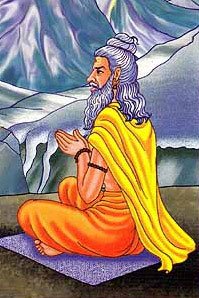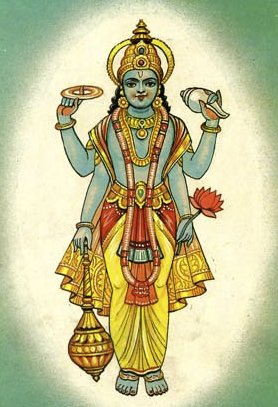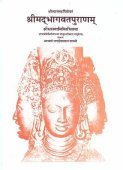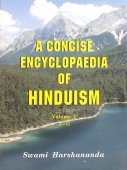Yogamaya, Yogamāyā, Yoga-maya: 13 definitions
Introduction:
Yogamaya means something in Hinduism, Sanskrit, Marathi. If you want to know the exact meaning, history, etymology or English translation of this term then check out the descriptions on this page. Add your comment or reference to a book if you want to contribute to this summary article.
In Hinduism
Purana and Itihasa (epic history)
Source: archive.org: Shiva Purana - English TranslationYogamaya (योगमय) or Mahāyogamaya refers to “yogic potentialities”, according to the Śivapurāṇa 2.2.40.—Accordingly, as Brahmā narrated to Nārada:—“[...] after going beyond Alakā, the capital of the king of Yakṣas and the Saugandhika park, they saw the fig-tree of Śiva. [...] Beneath that vaṭa of yogic potentialities (i.e., yogamaya), Viṣṇu and other Devas saw Śiva seated. The vaṭa was the refuge of those seeking salvation. Śiva was being served and venerated by Brahmā’s sons, the great Siddhas engrossed in devotion to Śiva joyously. They were calm. Their very physical body inspired calmness”.
Source: Cologne Digital Sanskrit Dictionaries: The Purana IndexYogamāyā (योगमाया).—Ordered by Hari to transfer the dhāma of His in the womb of Devakī to that of Rohiṇī; she was to take birth as the daughter of Yaśodā and Nanda, at the same time he became Kṛṣṇa. She would be worshipped by all as Durgā, Bhadrakālī, Ambikā. She did as was commanded. Born of Yaśodā: taken to prison by Vasudeva leaving Devakī's babe at Yaśodā's bed. Dashed against a rock by Kaṃsa, she predicted that soon a baby born already would kill him (See Viṣṇumāyā).*
- * Bhāgavata-purāṇa X. 2. 6-15; 3. 45[1]-53; 4. 7-13, 29.

The Purana (पुराण, purāṇas) refers to Sanskrit literature preserving ancient India’s vast cultural history, including historical legends, religious ceremonies, various arts and sciences. The eighteen mahapuranas total over 400,000 shlokas (metrical couplets) and date to at least several centuries BCE.
Pancaratra (worship of Nārāyaṇa)
Source: archive.org: Isvara Samhita Vol 1Yogamāyā (योगमाया) refers to “miraculous power”, acquired by practising yoga. Śrī mentions that she came to be called as Yogamāyā, that she joins things together which are hard for others. Therefore she is called Yoga and also as Yogamāyā. She is raised to the status of a deity. Kṛṣṇa asked Yogamāyā to take the token from the womb of Devakī and put it within that of Rohiṇī.

Pancaratra (पाञ्चरात्र, pāñcarātra) represents a tradition of Hinduism where Narayana is revered and worshipped. Closeley related to Vaishnavism, the Pancaratra literature includes various Agamas and tantras incorporating many Vaishnava philosophies.
Vaishnavism (Vaishava dharma)
Source: Pure Bhakti: Bhagavad-gita (4th edition)Yogamāyā (योगमाया) refers to “the internal potency of Bhagavān that arranges and enhances all His pastimes”. (cf. Glossary page from Śrīmad-Bhagavad-Gītā).
Source: Pure Bhakti: Bhajana-rahasya - 2nd EditionYogamāyā (योगमाया) refers to:—The internal potency of the Supreme Lord that engages in arranging and enhancing all His pastimes. (cf. Glossary page from Bhajana-Rahasya).
Source: Pure Bhakti: Brhad BhagavatamrtamYogamāyā (योगमाया) refers to:—The internal potency of Bhagavān that arranges and enhances all His pastimes. (cf. Glossary page from Śrī Bṛhad-bhāgavatāmṛta).

Vaishnava (वैष्णव, vaiṣṇava) or vaishnavism (vaiṣṇavism) represents a tradition of Hinduism worshipping Vishnu as the supreme Lord. Similar to the Shaktism and Shaivism traditions, Vaishnavism also developed as an individual movement, famous for its exposition of the dashavatara (‘ten avatars of Vishnu’).
Languages of India and abroad
Marathi-English dictionary
Source: DDSA: The Molesworth Marathi and English Dictionaryyōgamāyā (योगमाया).—f S Maya or illusion. See explained under māyā & brahma.
Marathi is an Indo-European language having over 70 million native speakers people in (predominantly) Maharashtra India. Marathi, like many other Indo-Aryan languages, evolved from early forms of Prakrit, which itself is a subset of Sanskrit, one of the most ancient languages of the world.
Sanskrit dictionary
Source: DDSA: The practical Sanskrit-English dictionaryYogamāyā (योगमाया).—
1) the magical power of the Yoga.
2) the power of God in the creation of the world personified as a deity; (bhagavataḥ sarjanārthā śaktiḥ); नाहं प्रकाशः सर्वस्य योगमायासमावृतः (nāhaṃ prakāśaḥ sarvasya yogamāyāsamāvṛtaḥ) Bhagavadgītā (Bombay) 7.25.
3) Name of Durgā.
Yogamāyā is a Sanskrit compound consisting of the terms yoga and māyā (माया).
Source: Cologne Digital Sanskrit Dictionaries: Shabda-Sagara Sanskrit-English DictionaryYogamāyā (योगमाया).—f.
(-yā) 1. The personified power of god in the creation of the world. 2. Durga.
Source: Cologne Digital Sanskrit Dictionaries: Cappeller Sanskrit-English DictionaryYogamāyā (योगमाया).—[feminine] magic, charm, spell.
Source: Cologne Digital Sanskrit Dictionaries: Monier-Williams Sanskrit-English Dictionary1) Yogamaya (योगमय):—[=yoga-maya] [from yoga] mf(ī)n. resulting from self-c° or Yoga, [Mahābhārata; Pañcarātra; Bhāgavata-purāṇa]
2) [v.s. ...] m. Name of Viṣṇu, [Pañcarātra]
3) Yogamāyā (योगमाया):—[=yoga-māyā] [from yoga] f. magic, [Kathāsaritsāgara]
4) [v.s. ...] the Māyā or magical power of abstract meditation, [Bhāgavata-purāṇa]
5) [v.s. ...] the power of God in the creation of the world personified as a deity
6) [v.s. ...] Name of Durgā, [Apte’s The Practical Sanskrit-English Dictionary]
[Sanskrit to German]
Sanskrit, also spelled संस्कृतम् (saṃskṛtam), is an ancient language of India commonly seen as the grandmother of the Indo-European language family (even English!). Closely allied with Prakrit and Pali, Sanskrit is more exhaustive in both grammar and terms and has the most extensive collection of literature in the world, greatly surpassing its sister-languages Greek and Latin.
See also (Relevant definitions)
Starts with: Yogamayadevi, Yogamayajnana.
Ends with: Buddhiyogamaya.
Full-text (+94): Yogamayajnana, Ishani, Buddhiyogamaya, Sharada, Nandatmaja, Vishnumaya, Kanyaka, Vindhyavasin, Narayani, Raghu, Madhavi, Candika, Vaishnavi, Acala, Dhamaka, Malakara, Vilapa, Caurangi, Amarai, Naciketa.
Relevant text
Search found 31 books and stories containing Yogamaya, Yoga-maya, Yoga-māyā, Yogamāyā, Yōgamāyā; (plurals include: Yogamayas, mayas, māyās, Yogamāyās, Yōgamāyās). You can also click to the full overview containing English textual excerpts. Below are direct links for the most relevant articles:
The Bhagavata Purana (by G. V. Tagare)
Notes regarding Rādhā and Yogamāyā < [Appendices]
Chapter 85 - Restoration of his Elder Brothers by Kṛṣṇa (from the Realm of Death) < [Book 10 - Tenth Skandha]
Part 4 - The Teaching of the Bhāgavata Purāṇa < [Introduction]
Garga Samhita (English) (by Danavir Goswami)
Verse 1.5.33 < [Chapter 5 - The Lord’s Appearance]
Verse 1.11.60 < [Chapter 11 - Description of Śrī Kṛṣṇacandra’s Birth]
Verse 1.11.43 < [Chapter 11 - Description of Śrī Kṛṣṇacandra’s Birth]
Brihad Bhagavatamrita (commentary) (by Śrī Śrīmad Bhaktivedānta Nārāyana Gosvāmī Mahārāja)
Verse 2.4.173 < [Chapter 4 - Vaikuṇṭha (the spiritual world)]
Verse 2.4.164 < [Chapter 4 - Vaikuṇṭha (the spiritual world)]
Verse 1.3.33 < [Chapter 3 - Prapañcātīta (beyond the Material Plane)]
Shrimad Bhagavad-gita (by Narayana Gosvami)
Verse 4.6 < [Chapter 4 - Jñāna-Yoga (Yoga through Transcendental Knowledge)]
Verse 7.25 < [Chapter 7 - Vijñāna-Yoga (Yoga through Realization of Transcendental Knowledge)]
Verse 10.17 < [Chapter 10 - Vibhūti-yoga (appreciating the opulences of the Supreme Lord)]
The Devi Bhagavata Purana (by Swami Vijñanananda)
Chapter 23 - On the birth of Śrī Kṛṣṇa < [Book 4]
Chapter 1 - On the superiority of Rudra over Viṣṇu < [Book 5]
Chapter 20 - On Devakī’s marriage < [Book 4]
Bhajana-Rahasya (by Srila Bhaktivinoda Thakura Mahasaya)
Related products

